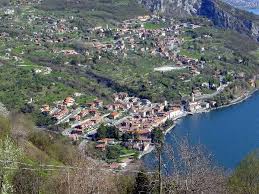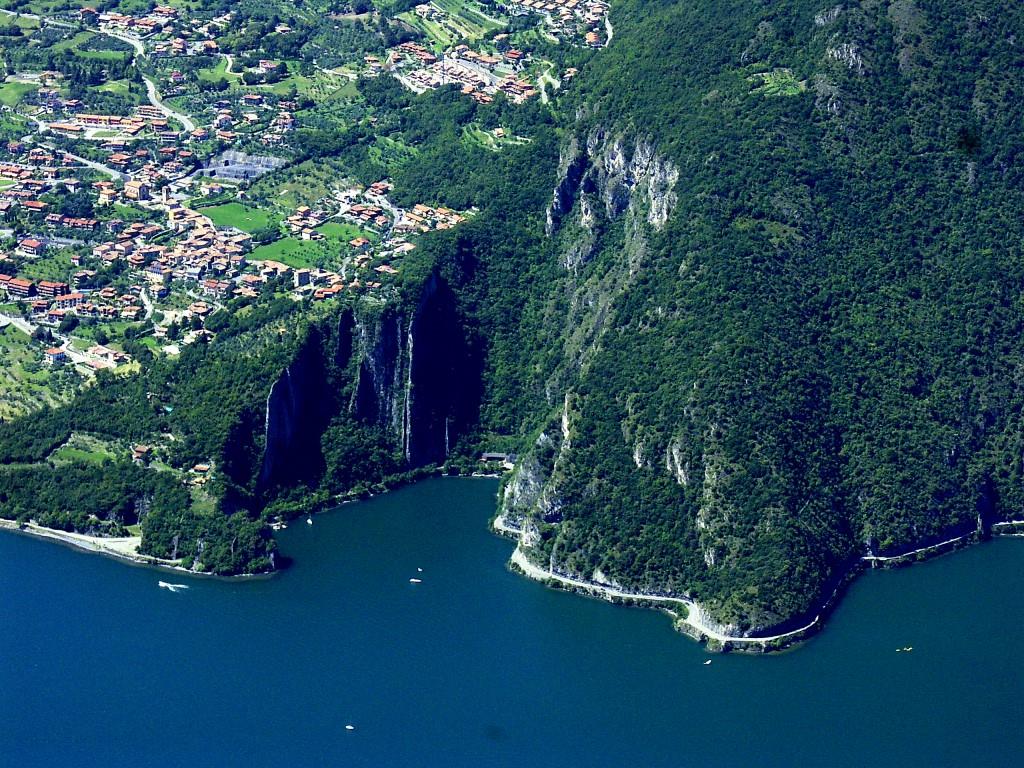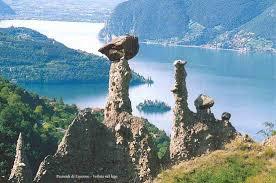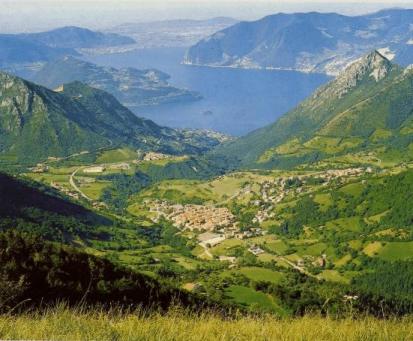Informations touristiques, excursions
Le Sentier du Bogn
Il est un beau sentier en boucle autour d'un ravin sur une baie de fonctionnalité du lac d'Iseo à 300 mètres d'altitude et facile de marcher dans environ 1,40 heures. Redécouvert et remis en état par le propriétaire du château. À partir du château remonte sur la route pendant 50 mètres puis sur une petite route à droite, puis vers un chemin qui atteint le lac, traverser la route (montre pour les voitures) et prendre la vieille route côtière construite en 1910, vous obtenez plus de le tunnel et suivez-le avec une petite chapelle d'où le sentier de la forêt ombragée par une végétation inhabituelle de chênes. Chaque domine si souvent la gorge offrant une vue sur le lac et le ruisseau, une nature commerciale du port antique, qui devient de plus en plus grandiose Plus vous montez. Il descend ensuite sur les routes et les sentiers qui mettent en Zorzino.
Une autre particularité est sa caractéristique du paysage sauvage, étant un site géologique régionale, la présence de calcaire Zorzino, plus de 200 millions d'années, poussé pour les montagnes dans une position verticale.
Multilingue Carte et fichier GPX
_____________________________________________________
Lake Iseo (Sebino)
Lake Iseo is really different from any other lake: simple and picturesque, at once tame and wild. A Romantic Lake, dear to poets and painters. Set in a splendid range of mountains, fed by the Oglio river, at 185 meters above sea-level, the lake has a maximum depth of 251 meters, an average width of 2,5 kms and a 60 Km. perimeter. It is also called Lake Sebino (from the Roman «Sebinus Lacus») and is the seventh longest lake in Italy. It lies only a few kilometers from Bergamo and Brescia and from the Orio al Serio and Linate Airports. At the centre of the lake stands Monteisola, the largest Iake island in Europe. There are also two smaller islands; one to the north, one to the south, called Loreto and S. Paolo. An amazing variety of natural beauties in a landscape confinually changing in light and colour. In summer the climate is cooled by constant breezes and in autumn and winter sunny days are frequent. The small lakeside towns are pleasant to visit and explore, full of memories of their glorious past and with deep-rooted traditions.
History is always present whilst modem life rarely intrudes on the peaceful atmosphere. All along the coast there are comfortable hotels, boarding-houses, camp sites and modern facilities far bathing and all other sports. A short trip from the Sebino will take you fo Capodiponte, whose neolithic age engravings attract scholars from all aver the world. Boario Terme and Angolo Terme are well-known spas. The Franciacorta region covered in vineyards produces a number ot well-known wines; Montecampione is famous far winter sports.
_____________________________________________________
Bossico
A lovely holiday resort on a sunny plateau about 1000 meters above sea-level covered with meadows and chestnut and pine woods. From here there is a wonderful view ot the lake and mountains. In the old village, visitors will appreciate the typical narrow streets, doorways and wooden balconies. The XVIIIth century parish church and that of S. Rocco of the same period are both worth visiting.
_____________________________________________________
Castro
This ancient tortified town clustered around a XVIIth century parish church probably takes its nome from the Roman and medieval castrum” situated on the hill known as the ‘Rocca”. Il is a typical lakeside trading village: the harbour has buildings that were once stores, and narrow streets climbing up beyond it. One can see the ruins al a Guelph tower. At the mouth al the river Borlezza one can admire the striking beauty ot the awesome cliff know as the “Bogn” of Castro.
_____________________________________________________
Riva di Solto
A picturesque tishing vil’Iage, winding along the shore beneath hills covered in olive groves and vineyards. Higher up, above the road, the old centre, Zorzino, is a maze ot winding streets and subterranean passages. Traces of medieval fortitications are visible (the Castle of Zorzino). The Palace of the Counts Martinoni di Caleppio is also of interest. Nearby, the Zorzino ‘Bogn”, with its vertical slabs of limestone, is certainly the wildest and most lonely inlet of the whole lake.



_____________________________________________________
Solto Collina
A collectian of streets facing the sun and with beautitul panoramas. In Dosso stands a group of medieval houses. In the heart of this village is a Xllth century tawer-house, with thick grey stone walls and typical arched portals.lnside the parish church, dedicated to the Assumption of the Virgin, there is a large XVIIIth century wooden choir stall by Andrea Fantoni.
_____________________________________________________
Fonteno
Set in a valley surrounded by woods and meadows, this is a typical mountain village with narrow cobbled streets,old stone houses and balconies overlooking the lake. A quiet corner where men and animals live in peace. The countryside is dotted with farmhouses frequently visited by the agritourism groups. Further down the valley, in a village called Xino, there is a very interesting XVllth century church dedicated to St. Carlo.
_____________________________________________________
Lovere
Lovere winds along the north-western shore, a succession of buildings and monuments clustered together in a medieval town centre built on descending plains. The Basilica of S. Maria in Valvendra (XVth century), the Municipal Tower (XlVth century), the Alghisi Tower (XIII century), the Soca Tower (Xlllth century), the church of S. Giorgio Martire (XlVth century) and the Torricella fortress (Xlllth century) are all built to follow the terrace-like slope. People particularly interested in art will find further interest in the XlXth century Tadini palace rooms which house a rich picture gallery, a valuable collection of sculptures, ceramics and arms and which is also the centre for a substantial season of lectures and concerts. The impressive ruins of a Gallic castle (lVth to lllird century BC.) at the foot of Mt. Cala are proof of the ancient origins of Lovere.
Immense panoramas con be admired from the S. Giovanni Sanctuary on Mt. Cala (once a Franciscan hermitage) and from the Loveresi Sanctuary. The town is a busy centre of commerce, cultural activities, the arts, sport and tourism. Boating, sailing, windsurfing and canoeing clubs, restaurants and entertainment facilities make Lovere one of the most pleasant and popular holiday resorts.
_____________________________________________________
Sarnico
Set at the foot of a hill, surrounded by a large morainic amphitheatre. Remains of palafitte houses indicate that the town was already inhabited in prehistoric times and became a fortified village in the Middle Ages (remains of the castle and part of the walls are extant). Sarnico is a busy holiday and commercial centre. A pleasant resort with wide squares giving onto the lake, a town centre with rustic buildings, a tree-lined lakeside, hotels and restaurants. Here you will also see many works by G. Sommaruga, one of the major ltalian Art Nouveau architects. During the restoration of the S. Nazario and S. Rocco churches in a village called Castione, Xlth century frescoes were recently discovered. Castione has some important motor-boat factories, and it is also equipped for water-skiing and speed-boat racing. Many international competitions are held here as well as attempts at breaking speed records.
_____________________________________________________
Iseo
This is an internationally famous holiday resort. It is known for its bright and open natural environment, its medieval town centre, and the lakeside holiday camp of Sassabanek which offers a large variety of entertainments.La Pieve di S. Andrea (Xllth century) with its romanesque bell-tower and the F. Hayez masterpiece, the Arcangelo S. Michele’, the Oldofredi castle (XIth century), now converted into a modern cultural centre, the church of S. Maria del Mercato with its recently discovered Xllth and XlVth century frescoes, the medieval Palazzo dell’Arsenale, the church of S. Silvestro and the baptistery of S. Giovanni are among the most important monuments. Just outside lseo the ‘torbiere sebine” marsh is a protected area of great interest for its flora and fauna and for its archeological value (remains of the palafitte civilisations). In the restaurant of a village called Clusane one can sample all the delicious varieties of lake fish. The Carmagnola Castle (XIVth century) overlooks the village from the top of a steep slope.
_____________________________________________________
Montisola
A green oasis of silence, this is the biggest lake island Europe. Motoring is forbidden, except for public utility. A constant ferry service connects the island to the mainland towns. Simple houses line the cobbled alleys of the many picturesque fishing villages along the lakeside, whilst higher up among olive groves, vineyards and chestnut woods there are villages with curious portals, loggias, courtyards and covered passageways which open on to breathtaking views of the lake below. The Oldofredi-Martinengo fortress (XIVth - XVIth century) stands on a promontory on an adjacent hilltop. At Siviano stands the Martinengo tower. Near the harbour stands the suggestive XVIth century Villa Ferrata. The Madonna della Ceriola Sanctuary is built on the highest peak at 600 meters. To the north and south respectively are two small islands: Loreto and S. Paolo.

_____________________________________________________
Zone
Zone lies in a luxuriant ever-green valley at the foot of Mt. Guglielmo (1949 meters) surrounded by beech and fir woods. A starting point for walks that ofter sweet but wild landscapes. Before Cislano, one sees an unusual sight: the pyramids of erosion, thin towers of earth up te 30 meters high, surmounted by granite boulders, caused by the gradual erosion of the morain deposits. Also well worth visiting are the parish church of S. Giorgio, Xlllth century, with its beautiful XVlth frescoes on the outside walls, and the smaller XVth century churches S. Cassiano and S. Antonio and the XVlllth century parish church with its famous central altarpiece and Deposition by A. Fantoni. There are many restaurants and inns that serve plain but excellent food.
_____________________________________________________
Capodiponte
This is the richest centre in Europe for stone engravlngs. Here the prehistoric lnhabitants of the Valle Camonica have left a testimony of their life and culture (4000 B.C.) engraved on the rocks. Groups of engravings can also be seen in the villages of Cemmo and Niardo. UNESCO included these places in its lisf of sites of worldwide artistic interest to be valued and preserved.

_____________________________________________________
Franciacorta
is a land marked by the gentleness of the morainic hills, where green meadows and woods are still vast and well protected. Being located south f Iseo Lake and, therefore, of Camonica Valley, it benefits of a mild, fresh and ventilated climate. It is easily reachable from the motorway A4 Milan-Venice, being comprised within the tract of Palazzolo-Rovato-Ospitaletto-Brescia West exits. It is a land with a great tradition of artistic handicraft which is well expressed inthe restoration of ancient furniture and in the art of wrought iron. The production of very valuable White - Red and Franciacorta D.O.C. wines is famous. Every year, between the end of August and beginning of September, the municipal authorities of Corte Franca organize the ‘Fair of antique, restoration and traditional products of Franciacorta”. The areas of a considerable scenic interest are two: the upper part of the Oglio Park and the Natural Reserve of lseo Peat-bogs with an extension of 360 hectares, which is destined to the repopulation of several species of fish (pike, tench, carp, catfish, perchis, trout and eel) and birds (coot, cuckoo, mallard, heron, Cetti's warbler and others) and may be visited following a pedestrian itinerary. Traditional destination for summer holidays of noble Brescian families, Franciacorta is rich of wonderful villas and country-houses. its rich history is documented by ruins, imposing castles, abbeys, monasteries, churches, parish churches and sanctuaries, among which the Abbey of Rodengo Saiano, the Romanesque San Pietro in Lamosa parish church in Provaglio d'Iseo, the Annunziata Monastery in Rovato, Villa Lechi in Erbusco, Palazzo Bargnani dandolo in Adro, villa Togni in Gussago and still many others. The careful touristic development is providing Franciacorta with prestigious tourist facilities, giving particular consideration to the protection of the environment. The opportunities for sport activities are several horse riding is the ideal sport to discover the territory, however, the 20 cycle-itineraries for mountain bykes are also an excellent opportunity: 550 km of traced and signalled tracks that lead to the discovery of the most picturesque out-of-the-way places. The peacefulness of the golf course of Franciacorta is only 3 km distant from lseo and from the turnpike of Rovato. Wonderful water-games and 1 200 mq swimming-pools are available in thewater-amusement park Acquasplash of Corte Franca. Gastronomy is simple and genuine; home-made pasta, charcuterie, several types of cheese and, once again, wines and eaux-de-vie from various species of vines. Franciacorta, a real oasis of peacefulness, offers the opportunity of a quiet holiday in the nature.
_____________________________________________________
Bergamo
Two cities stand one above the other, Upper Bergamo and Lower Bergamo. The former is a museum-city, the most Venetian in Northern Italy (after Venice of course); a collection of towers, spires and steeples all gathered inside the magnificent walls. In Piazza Vecchia”, one of the most beautiful squares in the world, Is the Renaissance Ragione Palace and behind, in a small and harmonious square is the Xllth century Basilica of S. Maria Maggiore and the XVth century Colleoni Chapel. Amog the artistic treasures: the Gothic facade of the Xlllth century ex-church of S. Agostino, the cloister of the ex S. Francesco Monastery and the S. Michele al Pozzo Bianco arcade. The Accademia Carrara, one of the most important picture galleries in the world, and the Donizettiano Museum should be visited. Lower Bergamo is a residential area, an important industrial and commercial centre.
_____________________________________________________
Brescia
A city of great historical and artistic interest. There is Roman Brescia, built around the Piazzetta del Foro, with the exceptional Capitoline Tempie (inside there is a Roman museum with the famous Winged Victory statue), There is Medieval Brescia stretching from the Broletto (the ancient town hall) to the round Duomo Vecchio, from the Castello on the Cidneo hills to the monumental complex of S, Salvatore and S. Giulia, an incredible tangle of architectural superimposition, Roman ruins to which have been added Barbarian, Lombardic, Carolingian, Feudal, Communal and Ranaissance structures. In the XVth century Brescia was known as “the city of a hundred convents”: of these there remain some exemples such as S. Cristo, S. Faustino, Santa Maria del Carmine and S. Francesco. The Piazza della Loggia is of the Renaissance period and the Duomo Nuovo is XVllth century. Two great Brescian painters, Romanino and Moretto, competed with each other during the Renaissance. Their works may be seen in the art gallery in Piazza Moretto.
_____________________________________________________
The nature
The area offers a truly amazing variety of plant species ranging from the variety of Mediterranean species purely alpine influenced by the variety of altitude and geological formations present. When you want to leave the lazy banks of the lake it finds the shady stillness of the woods that surround the mountains from many routes. With a little 'care you can do extraordinary meetings, as the sudden frullar wings of a partridge or glimpse the stealthy gait of a deer. Many aquatic species present.
_____________________________________________________
Entertainment
The holiday at Lake Iseo is something for everyone: you will be spoiled for choice sunbathe, take a boat ride or play sports such as swimming, sailing, tennis, canoeing, ippoturismo or raid biking, trekking and hiking the trails of the many mountains, mountaineering, rock climbing in natural many rock climbing, summer skiing, etc ...
The varieties' Landscape of the lake, in fact, offers many opportunities' for the most 'sports. Also there is the possibility 'to participate in courses and schools qualified for each discipline.
In the evening the lights of the restaurants and meeting places where you can cheerfully await the return of the sun.
_____________________________________________________
Health and Beauty
There are many spas in the area: The renowned "Terme di Boario" at km 22, the "Baths of Trescore Balneario" at km 20, "Terme Gaverina" at km 13, "Baths of Angle" at 22 km offer the possibility of thermal treatments, mud baths, massages, beauty treatments by adding the times of health and relaxation holiday.
The nearest hospital is in Lovere at Km 10.
_____________________________________________________
Food and Wine
Sit at the table means rediscover the authentic flavors of simple cooking, but tasty, offering meat and fish and sweets prepared according to recipes that have taken the best of traditional Alpine foothills.
The civilization of the vine and good drink is with the production of white and red wines of the renowned nearby land of Franciacorta.
In keeping with the best traditions of wine production are small companies that produce oil exceptional cheeses esalumi unique.
Definitely it can 'be worth spending an afternoon to taste the specialties of the wineries.
_____________________________________________________
Markets
Who wants to go shopping or browsing can choose from these markets.
| Monday | Clusone | all day |
| Tuesday | Solto Collina | morning |
| Tuesday | Trescore | morning |
| Wednesday | Costa Volpino | morning |
| Thursday | Sarnico | morning |
| Friday | Pisogne - Iseo | morning |
| Wednesday | Riva di Solto | morning |
| Saturday | Lovere | morning |
_____________________________________________________


